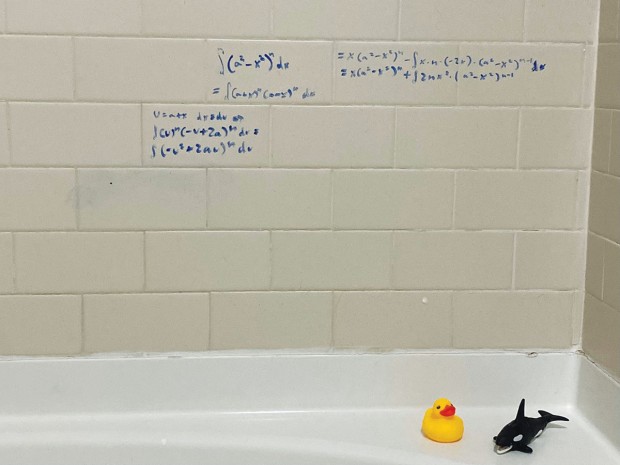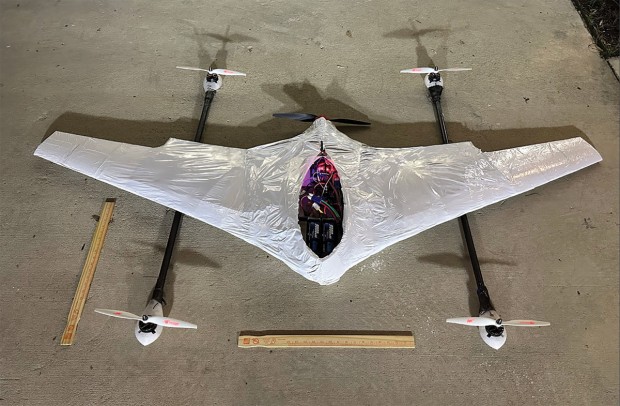Sine of Success
Carnegie senior wins big at international science fair

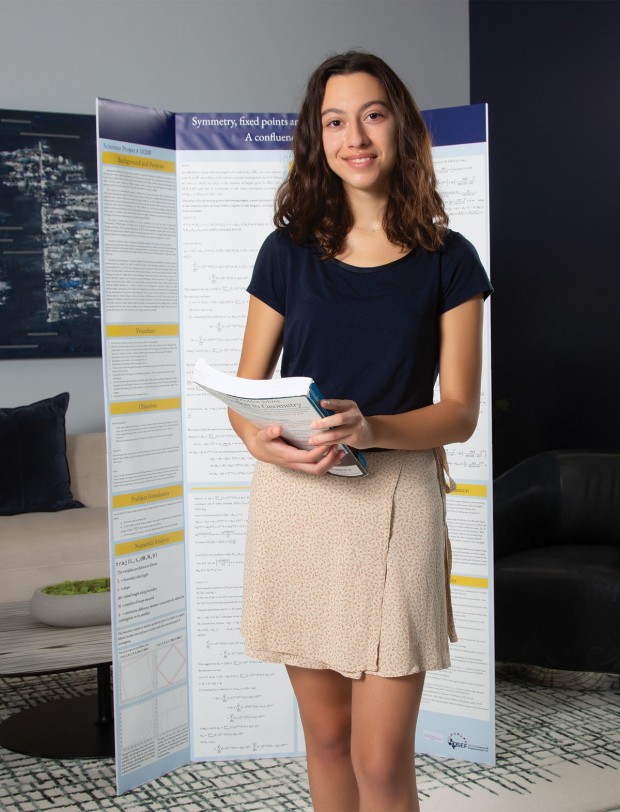
Anna Oliva, 17, won first prize in the Mathematics category at the prestigious International Science and Engineering Fair. (Photo: lawellphoto.com)
A quick glance around 17-year-old Anna Oliva’s bedroom reveals the variety of her passions: Pythagorean equations written in dry-erase marker on the bathroom shower wall complement stacks of fantasy books and her at-home nursery of flowering plants, one of which was propagated from a cutting originally belonging to Albert Einstein. A painting of the Swiss Alps leans against one wall, serving as a reminder of her European roots.
Born in Milan, Italy, Anna moved to Boston at age three when her parents, both professors, accepted jobs at Boston College and again at age seven to Houston. From a young age, Anna shared her parents’ love of learning. During her elementary-school years, Anna sometimes felt underestimated due to the language barrier, as English is her second language. She felt minor grammatical errors sometimes isolated her from American classmates. More recently, she has found peers underestimate her intelligence because she is a girl in STEM. “People find it hard to reconcile their perceptions of aspiring scientists and mathematicians with my general attitude,” Anna said. “You don’t see young Sheldon Cooper shopping at Aritzia.” But she has never cared much about what others think and said she’s never doubted herself.
Now a senior at Carnegie Vanguard High School, Anna’s scholastic efforts have earned her a ticket to the Dec. 2024 Nobel Prize Award ceremony as an internationally recognized guest of Regeneron Pharmaceuticals.
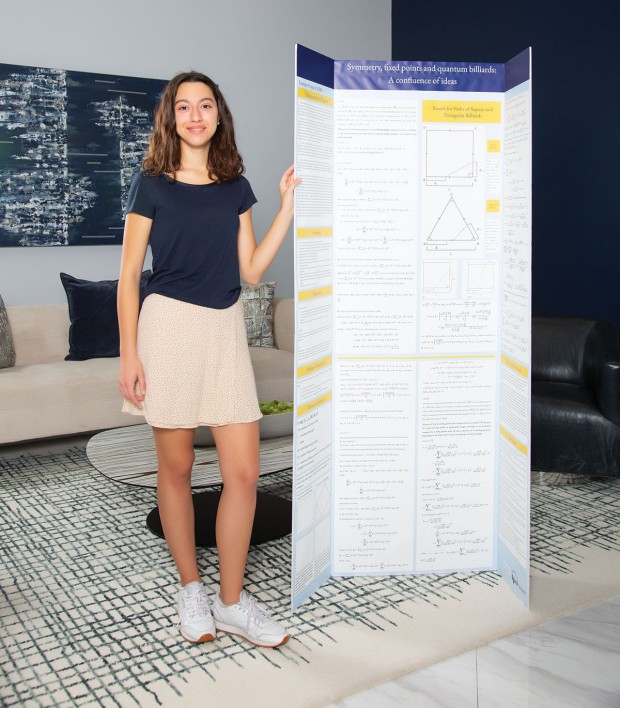
BRILLIANCE IN BILLIARDS Anna Oliva, a senior at Carnegie Vanguard High School, worked with mentor Daniel Onofrei at the University of Houston to prepare her research on the projected paths of mathematical billiards. She traveled with her trifold to city, state, and finally an international competition, where she won first prize in the Mathematics category. (Photo: lawellphoto.com)
Anna’s trip is one of several prizes that were awarded to her this May at the Regeneron International Science and Engineering Fair (ISEF) in Los Angeles, Calif., which is the largest pre-college STEM fair in the world. Scouts from institutions like CalTech and MIT surveyed leading youth scholars from over 66 countries as they presented their research. Anna’s project on mathematical billiards impressed local, state, and international judges, earning her first place in the Mathematics category, which received over 1,800 submissions.
Her prizes included $5,000 from category sponsor Akamai Technologies as well as an additional $1,000 from the American Mathematical Society. But the cherry on top is the Dudley R. Herschbach Award, which offered her a fully paid trip to Sweden this December to attend the Nobel Prize Award ceremony and Stockholm International Youth Science Seminar.
Anna conducted her research for ISEF at the University of Houston and was mentored by Mathematics professor Daniel Onofrei, who describes Anna as “very ambitious.” Using a combination of triangle laws and other theorems, she found that the reflection angle of an object with constant speed and direction against the surface of a regular polygon (one with equal side lengths and interior angles) has the same measure as the interior angle of that polygon. For example, the object bouncing off the side of a square would have a reflection angle of 90 degrees, and if it were to bounce off the side of an equilateral triangle, 60 degrees. These findings could have applications in creating navigation systems for AI-powered robots and optimizing the size and operating power of microchips.
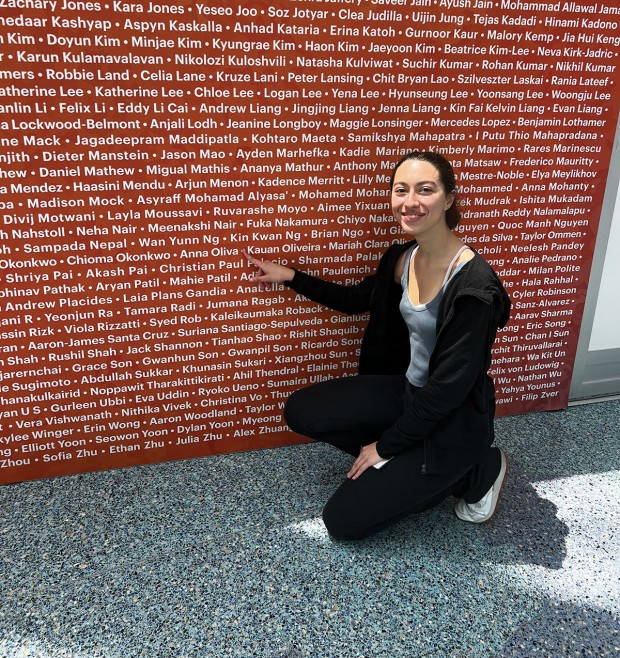
GOING, GOING, POLYGON Anna poses with her name on the wall of 1,800 International Science and Engineering Fair (ISEF) contestants.
“When I tackle a problem, I write it down in mathematical terms, write what I want to prove, and try to unravel it from there. For me, this involves sitting and thinking and scribbling on any available surface for hours,” Anna said. “The best proofs involve some sort of fun unintuitive leap that seems kind of painfully obvious once you see it.”
Evidence of her process can be found all around her, like the scribbles on the surface of her shower wall.
One of my first impressions of Anna, who (full disclosure) is one of my closest friends, was at her 12th birthday party. Her birthday falls near Halloween so wearing costumes to the party was, of course, required. She dressed as the ghost of Marie Antoinette, complete with wig, face paint, and hoop skirt.
In her everyday life, Anna always strives to go the extra mile – she takes pride in picking out the perfect outfit or spending hours cooking a good risotto – and her creative thinking, Onofrei agrees, is an integral part of her academic process as well.
“She understands ideas fast and has the power to make her own contributions,” he said. “She has a clear talent towards deductive thinking.”
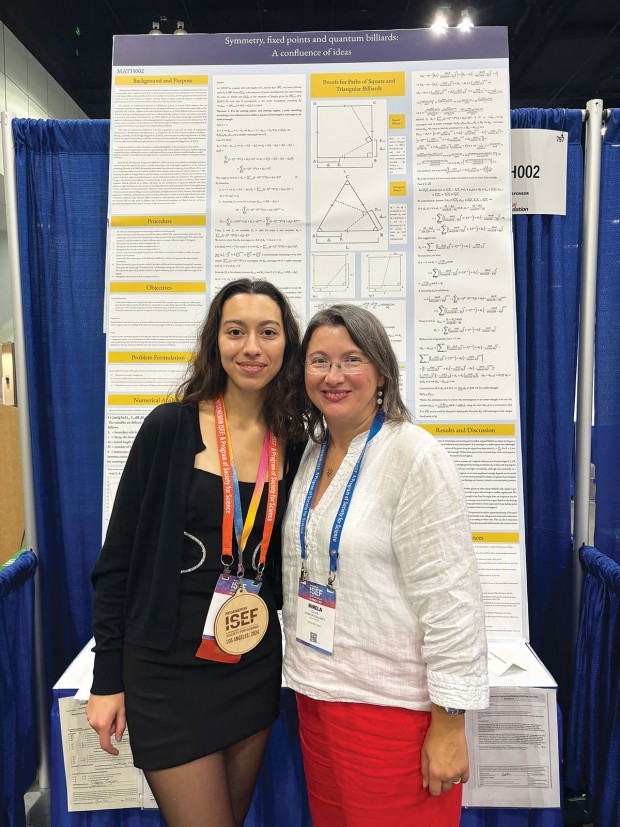
PLANTS AND PYTHAGORAS Mom Mirela accompanied Anna to the ISEF conference in Los Angeles, Calif., and served as an unofficial chaperone to the 24 Houston-area contestants.
Anna’s mother, Mirela, accompanied her to the ISEF conference in Los Angeles. She is a professor of religious philosophy at the University of St. Thomas and speaks six languages. Her father, Luca, is a professor of the philosophy of mathematics at the University of Houston. Both are published authors and frequently travel to teach at universities in Europe. It is no surprise that their daughter is equally intelligent and interesting.
Luca recognized his daughter’s intelligence early on and began teaching her advanced lessons at home. Logic proved too boring and Ancient History didn’t stick; Anna’s love of learning was sparked in earnest at age 7 when he gave her an algebra textbook from his college days.
Over the next few years, she self-studied with books that encouraged exploration and mathematical thinking instead of rote memorization. Hours spent deriving formulas and axioms fostered an affinity for complex equations and proofs. By first grade, Anna knew what she wanted to be when she grew up: either a scientist or a pop star.
“I settled on wanting to be an astrophysicist because I wanted to solve the discrepancies in the standard model,” Anna said. Perfecting the model, a set of proposed laws governing the physics of the universe, has stumped scientists since its creation in the 1970s. She has yet to solve the model, but age has never been an obstacle for Anna in her pursuit of learning. In addition to physics and botany, she also enjoys studying biology. She started studying the growth patterns of algae in the swamps of Louisiana last summer and continued her research this year at MIT’s Summer Research Program, held at Purdue University. Physics and mathematics are Anna’s way of explaining how the universe works. Though she is Catholic, “it’s kind of like part of my religion,” she says. “Biology is just fun.”
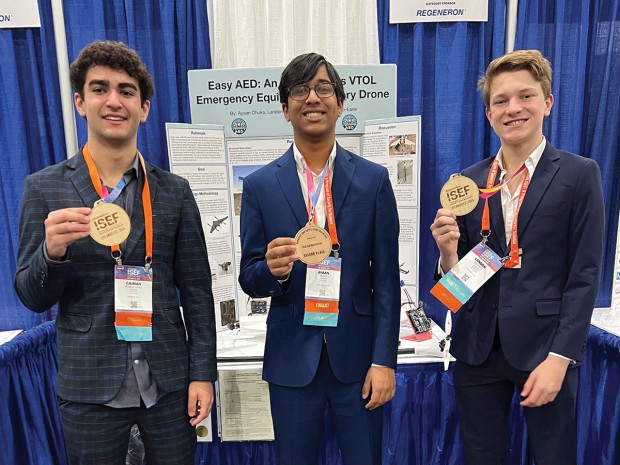
Caiman Moreno-Earle, Ayaan Dhuka, and Landon Doughty (pictured, from left), students at St. John’s School, placed second in the Engineering category for the second year in a row with their design for a quadcopter-drone hybrid designed to deliver defibrillators to rural areas.
Her talent for understanding abstract concepts found an outlet when she watched a documentary about the mathematics of the universe and decided she wanted to explore it, too. “She was always asking questions about the universe; it was like a show for us watching her every day,” Mirela said. “When she was three, we went on vacation, and she was so amazed that the sun was following us; that amazement about nature and patterns became a passion for order and math.”
Mirela says Anna has always defied the stereotype of the awkward genius. ISEF is a formal affair: boys wore suits and girls dressed in blazers and skirts. When Anna instead chose to stay true to her “fashionable” self – she wore fishnets to the award ceremony – Mirela thought none of the judges would take her seriously. “I thought it was going to be a disaster, but she won by being herself,” she said. “Lots of people that have met her recently have observed she isn’t some ‘weirdo science wizard’; she has the capacity to be very smart but also very approachable.”
Anna was not the only high achiever making Houston proud at ISEF; out of the 24 contestants from the city, more than half won awards, including some friends Anna first met during her time at Annunciation Orthodox School and competed against at city and state fairs: Ayaan Dhuka, Landon Doughty, and Caiman Moreno-Earle, all seniors at St. John’s School. Last year, they placed second in the Engineering category with their AI-powered magnetic chessboard.
This year, they continued their streak, once again taking second in the category with their quadcopter-drone hybrid used to transport defibrillators. The project, which the team began last May, was inspired by a drone system developed to deliver blood bags to rural African and South American villages. The boys’ drone is able to fly like a plane and also land vertically, maximizing the vehicle’s speed and navigability.
“I want to pursue engineering because I want to help people, I want to create solutions,” Landon said. “And I want to be known as someone who makes cool things.”
Anna shares the sentiment of wanting to unravel secrets of the universe and contribute something helpful to society. She looks forward to attending the prestigious Nobel Prize Award ceremony this winter and hopes to win a Nobel Prize of her own before age 30.
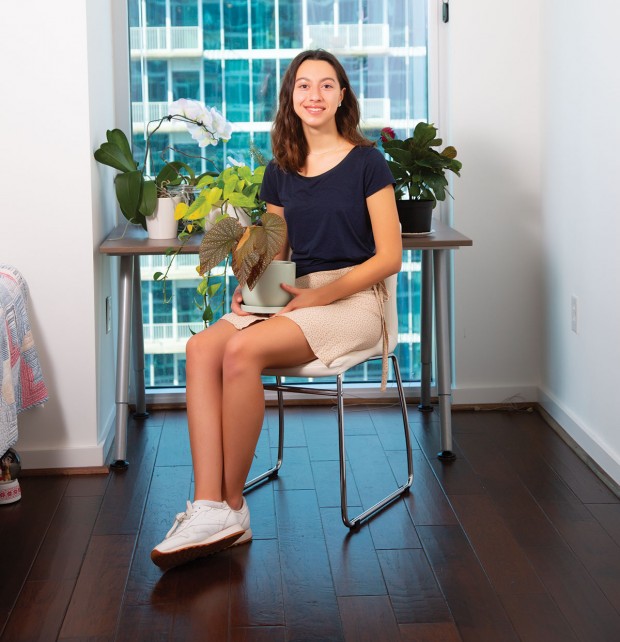
In addition to math, Anna loves biology; she has dedicated two summers to researching algae growth, is the founder of Carnegie’s botany club, and keeps a small nursery in her bedroom. (Photo: lawellphoto.com)
As college applications loom ever closer, Anna is optimistic for her future. She hopes to study math in college alongside physics and biology, pursue a PhD in mathematics, and continue to nurse her love of learning as a researcher or professor.
“I want to continue researching what fascinates me and do what I can to help humanity,” she said.
Want more buzz like this? Sign up for our Morning Buzz emails.
To leave a comment, please log in or create an account with The Buzz Magazines, Disqus, Facebook, or Twitter. Or you may post as a guest.


